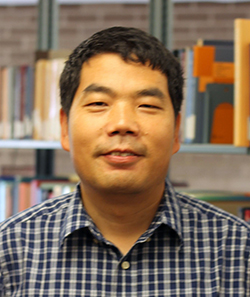Department of Physics
WIU Home > CAS > Physics > Contact Directory
Pengqian Wang, Professor

Phone: (309)298-2541
Fax: (309) 298-2850
Email:
P-Wang@wiu.edu
Personal Web Page:
http://faculty.wiu.edu/P-Wang
Education
- Ph.D. – Peking University, 1998
- B. S. – Peking University, 1992
Research Interests
My research interests are in experimental AMO physics, specifically in the following areas:
- Dynamics of molecules in ultrafast intense laser fields.
- Laser spectroscopy of atoms, molecules and clusters.
- Electron impact dissociative ionization of molecules.
- Nonlinear optical properties of materials.
The structure of molecules and their behavior in intense laser fields are of particular interest. When a free molecule is exposed to ultrashort intense laser pulses whose field strength is comparable to the internal Coulomb field of the molecule, various interesting phenomena may occur, such as laser-induced dissociation, dissociative ionization and dynamical alignment. The dynamics of laser-molecule interaction is microscopically investigated by coincidence 3-dimensional momentum imaging. Pulse amplified narrow band CW lasers are employed to explore the structure of biologically interesting molecules as well as their hydrated clusters, using the technique of mass-selective resonance-enhanced two-photon ionization spectroscopy.
Selected Publications
- “Disentangling the volume effect through intensity-difference spectra: Application to laser-induced dissociation of H2+”, P. Q. Wang, A. M. Sayler, K. D. Carnes, B. D. Esry, and I. Ben-Itzhak, Optics Letters 30, 664-666 (2005).
- “Dissociation and ionization of H2+ by ultra-short intense laser pulses probed by coincidence 3D momentum imaging”, I. Ben-Itzhak, P. Q. Wang, J. Xia, A. M. Sayler, M. A. Smith, K. D. Carnes, and B. D. Esry, Physical Review Letters 95, 073002 (2005).
- “High-resolution ultraviolet spectroscopy of p-fluorostyrene-water: evidence for a σ-type hydrogen-bonded dimer”, S. Chervenkov, P. Q. Wang, J. E. Braun, S. Georgiev, H. J. Neusser, C. K. Nandi and T. Chakraborty, Journal of Chemical Physics, 122, 244312 (2005).
- “Dissociation of multiply ionized isocyanic acid through electron impact”, P. Q. Wang, C. R. Vidal, J. Geith, T. M. Klapötke, and W. Fuss, Journal of Chemical Physics 120, 123-128 (2004).
- “Self-Compression of high intensity femtosecond optical pulses and Spatio-temporal soliton generation”, I. G. Koprinkov, A. Suda, P. Q. Wang, and K. Midorikawa, Physical Review Letters 84, 3847-3850 (2000).
- “Windowless, geometry-independent, phase-matched method for the measurement of the oscillator strengths of Xe, Kr, and Ar”, C. Tian, J. Li, P. Q. Wang, and T. Sun, Physical ReviewA50, 1133-1136 (1994).

Connect with WIU: